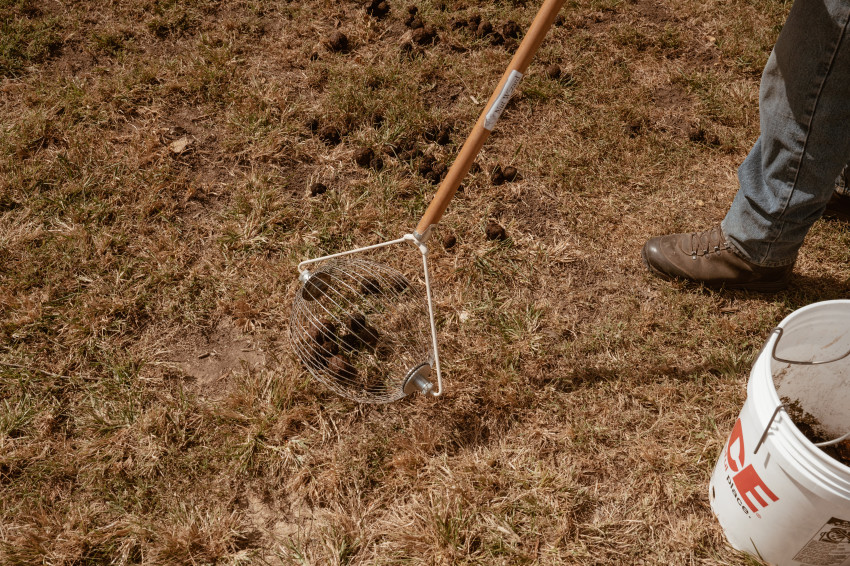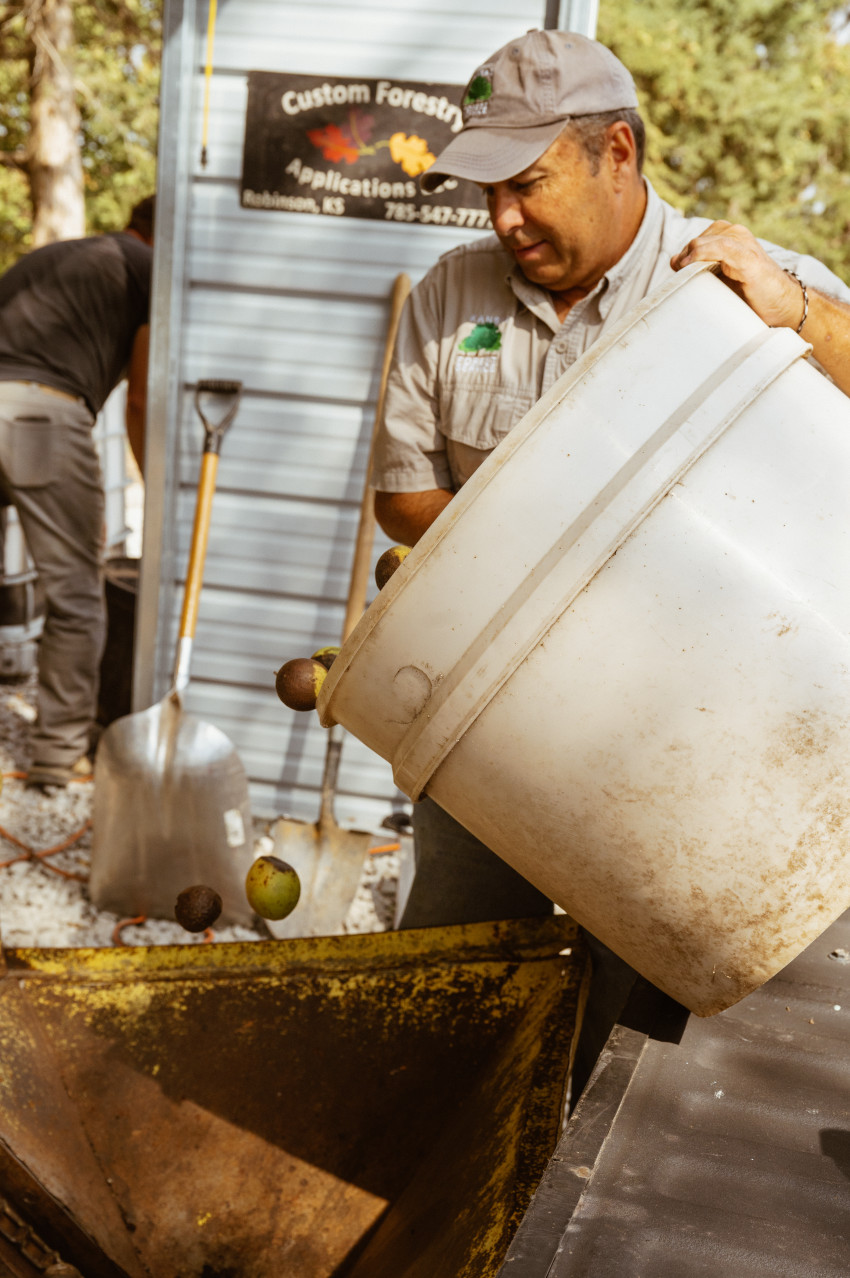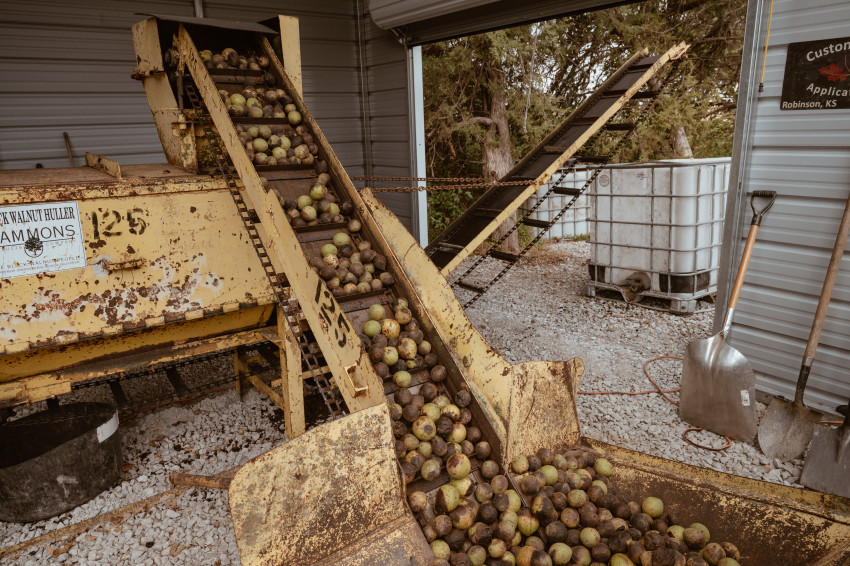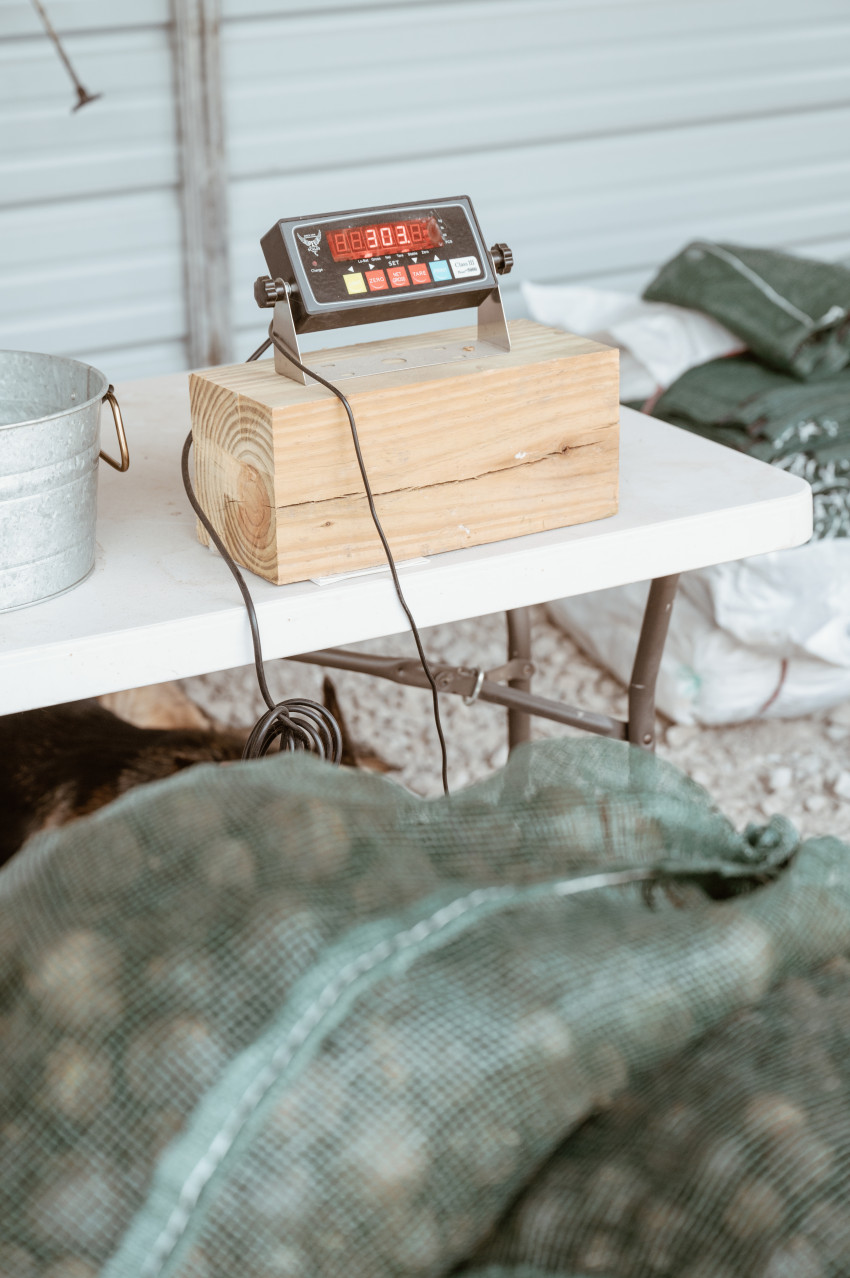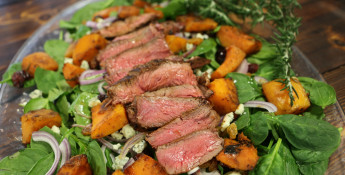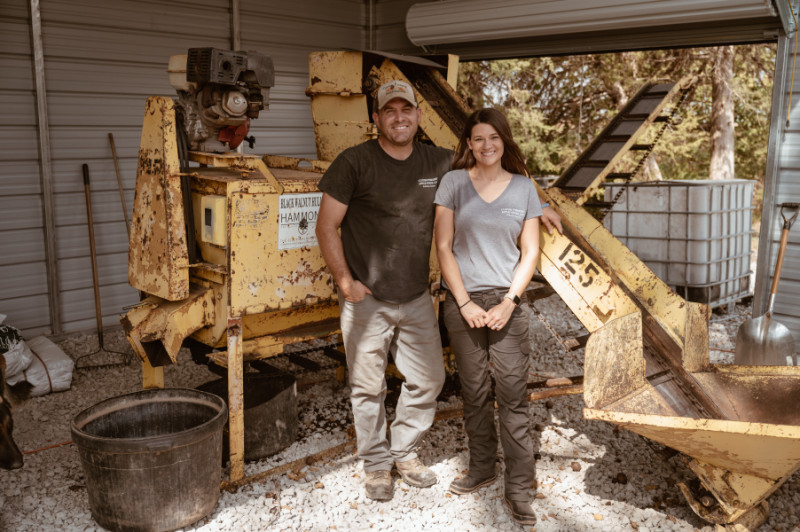By Sheridan Wimmer on October 8, 2023
Walnut Hulling Stations in Kansas Gain Traction
Harvesting walnuts in Kansas provides conservation and economic benefits

Typically, days in October conjure images of crisp, cool mornings and sweater weather. But on Oct. 2, temperatures topped off at 90 degrees while Luke and Jaime Terry of Robinson were gearing up for their first crack at walnut season.
Black walnut trees are native to Kansas’ eastern half of the state and although not a major commodity in Kansas, walnuts provide a different kind of opportunity for conservation and economic contribution.
Walnut hulling stations in Kansas are gaining traction. In 2022, there were six stations, and in 2023, there are nine. The option of adding the station to their farm was appealing to the Terrys because of Luke’s passion for and fascination with trees.
“If there’s one thing about Luke, it’s that he’s all about trees,” Jaime, Luke’s wife, says. “Anything a tree produces, he’s into. The walnut hulling idea is an added service to his business, Custom Forestry Applications, Inc., which provides forestry and habitat management with a focus on conservation.”
The nuts and bolts
Hulling walnuts requires a special machine – a very loud special machine – to remove the outer green covering of the nut (the hull) before they go to the processor. A company in Stockton, Mo., Hammons, has a rich history in processing black walnuts dating back to 1946 when Ralph Hammons, a grocer, saw the potential of wild walnut trees growing in Southwest Missouri. He bought a cracking machine, then purchased walnuts from locals. The company is still family-owned and processes millions of pounds of nuts every year.
“Keeping the passion in regard to black walnuts is really important to the company,” Alan Stauffacher, the procurement manager for Hammons, says. “There’s a strong tradition in southwest Missouri of walnut pickers. I’m part of a fourth-generation family of walnut harvesters. I grew up harvesting walnuts with my father, and now I get to enjoy continuing the tradition with my grandchildren.”
Hammons provides hulling machines to their huller contractors – a collection of more than 180 stations on farms in 13 states. When the Terrys visited Hammons to see if they’d be a good fit to hull walnuts on their farm in Brown County, they knew they wanted to give it a try.
“Over the summer, we were able to visit Hammons and that’s when we committed and said, ‘Yeah, we’re going to do this,’” Jaime says.
Stauffacher appreciates people like the Terrys who contract with them for walnuts.
“One of the qualities of our hullers is they can’t be afraid of hard work and getting a little dirt under their fingernails,” Stauffacher says. “We also need our hullers to be located somewhere that would be able to sustain a hulling location and we try to aim for places that can generate around 100,000 pounds of walnuts at least.”
Nut wizard to the rescue
The nine hulling stations in Kansas are all located along the eastern border of the state. The farthest west hulling station is in Burlingame, and the rest are scattered from Galena to the Terry station in Robinson.
“Whenever we talk about Kansas, we don’t often think about timberlands, but in the eastern portion of the state, there are a number of hardwoods and black walnuts,” Stauffacher says. “That’s where the focus is for us. If there’s a large enough quantity of black walnuts to sustain a hulling location, it gives us an opportunity to cross state lines.”
Dave Bruton, the utilization and marketing forester at Kansas Forest Service, has set his sights on increasing the number of stations in Kansas.
“Ideally having hulling stations scattered across the landscape every 30 miles or so would work out most economically for those gathering walnuts to reduce peoples’ time and transportation costs, but we are a long way from that,” Bruton says. “However, that means there are plenty of opportunities for others interested in establishing black walnut hulling stations."
Bruton delivered several buckets full of walnuts to the Terry farm on Oct. 2, which he harvested from a nearby Farm Bureau Century Farm using a device called a “nut wizard.” The innovative device looks like a large, sideways whisk on a long pole. You roll the nut wizard on the ground to collect walnuts instead of bending over to pick them up by hand.
“This gadget really saves your back and prevents your hands from becoming stained by the hulls,” he says.
They also save marriages.
“I had a woman in Lawrence call me once almost in tears because she had a big walnut tree in her yard and her husband twisted his ankle on a walnut that had fallen,” Bruton says. “She didn’t want to cut the tree down, which was her husband’s idea because he was tired of them being scattered on the ground and having to pick them up. I told her about the nut wizard, and I think I saved their marriage.”
Cracking the nut
People with walnuts to sell to a hulling station bring them to the location and unload the walnuts into a bucket on the hulling machine that carries walnuts up a conveyor belt. The walnuts drop down into a shaft with a continuous coil with chains that beat the hulls off the walnuts.
The hulls are ground and go out the other side of the hulling machine into a waste bucket. The Terrys have found a use for the hulls, too.
“Our neighbor raises pigs that love eating whole walnuts and helps with their marbling,” Luke says. “We’re going to coordinate with him to pick up the ground hulls and we are thrilled to have a way to use the entire walnut with zero waste.”
Other hullers have used the hulls as fertilizer, but it is not recommended for use in vegetable gardens.
Once they’re hulled, the walnuts are dropped down another conveyor and are collected in mesh bags. The bags are weighed, and customers receive their payment.
“This year, it’s $16 per 100 pounds of walnuts,” Luke says.
Hulling station location contractors get six cents per pound as commission for their work.
“We pay for the hulling machine, and we provide bags and signs and marketing,” Stauffacher says. “If a huller gets to that 100,000-pound mark we want for sustainability reasons, they’d get $6,000.”
At the end of the walnut season, which typically ends in mid-November, depending on the weather, Hammons will drive through each hulling station and pick up the bags of walnuts on a semi-truck to take to their Missouri facility for the final round of processing.
After pickup, Hammons shells the nuts, which removes the shell from the meat of the nut. The shells are ground to different grit sizes to use as abrasives and other products.
“They used walnut shells to sandblast the Statue of Liberty,” Bruton says. “They didn’t want a bunch of sand everywhere, and because it’s better for the environment, they went with the walnut shell abrasion method.”
Hammons hopes to buy a minimum of about 12 or 13 million pounds of walnuts from their hulling contractors this year. That amount will sustain their production operations for a whole year.
Nuts about walnuts
Some people get frustrated about having walnut trees when they fall onto the ground, but Bruton suggests taking them to a hulling station.
“We'd encourage people just to explore that option if they have interest and the interest in trying to utilize the natural resources in the area,” Bruton says. “Oftentimes, people cuss them this time of the year because they're hitting them with their lawnmowers or tripping on them as they're walking in and out of their house. We can make a win-win situation of utilizing the resource but also generating some economic return into the area.”
Bruton suggests kids and youth clubs look into the option for some extra money around the holidays.
“This kind of thing is a great opportunity for them to get a little bit of extra spending money and make them proud of spending that money on presents because of the hard work they put in. Walnuts provide another thread in the fabric that helps strengthen and add to our agricultural community. I am a firm believer that getting people outdoors, especially our youth, plays an important role in gaining a greater understanding and appreciation of our natural resources.”
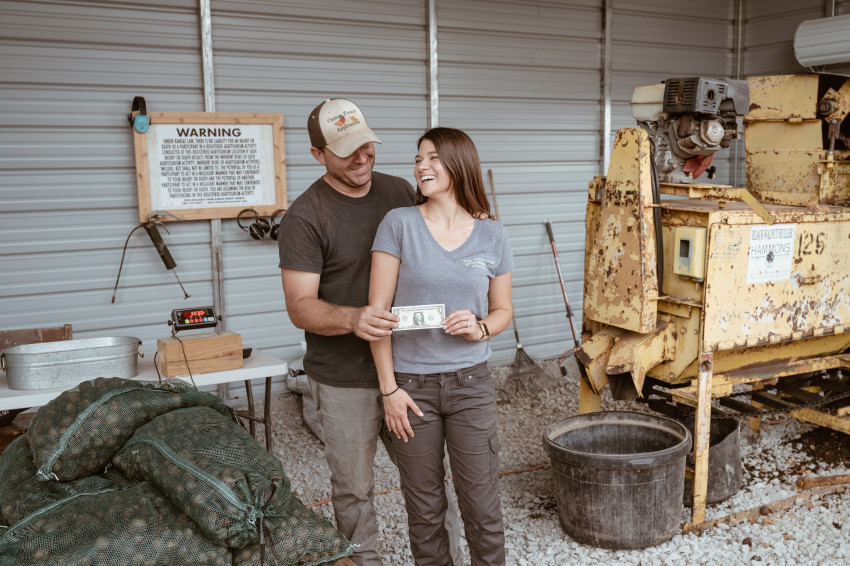
Luke and Jaime Terry of Robinson celebrate their first walnut hulling sale with their first dollar.
To find a walnut hulling station near you, visit the map on Hammons’ website here. If you’re interested in being a hulling station, reach out to Hammons.




